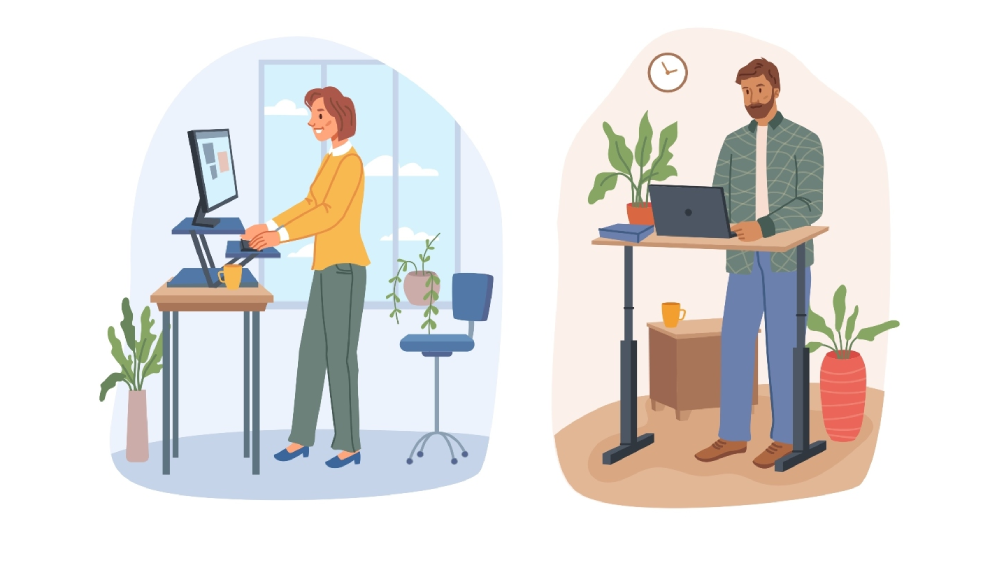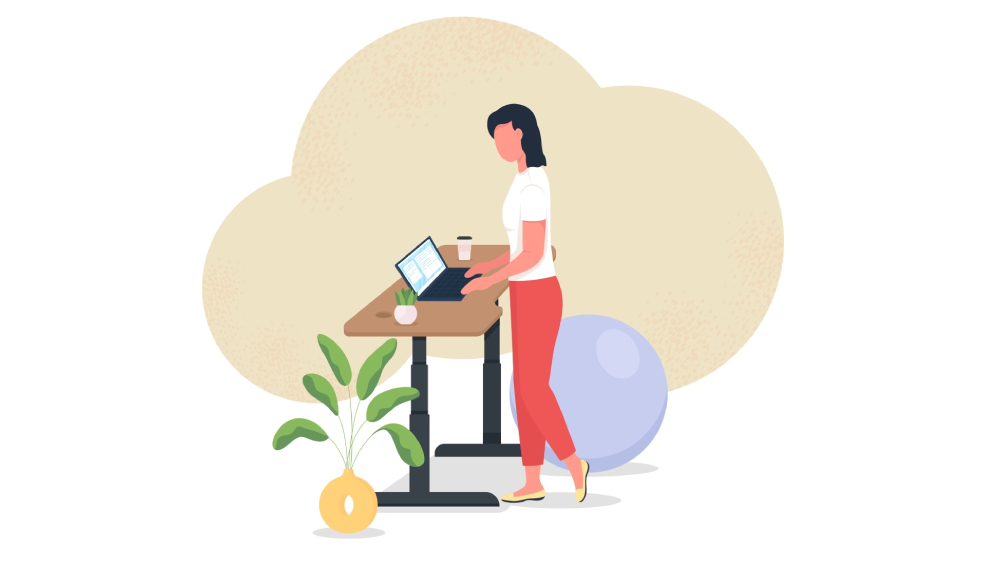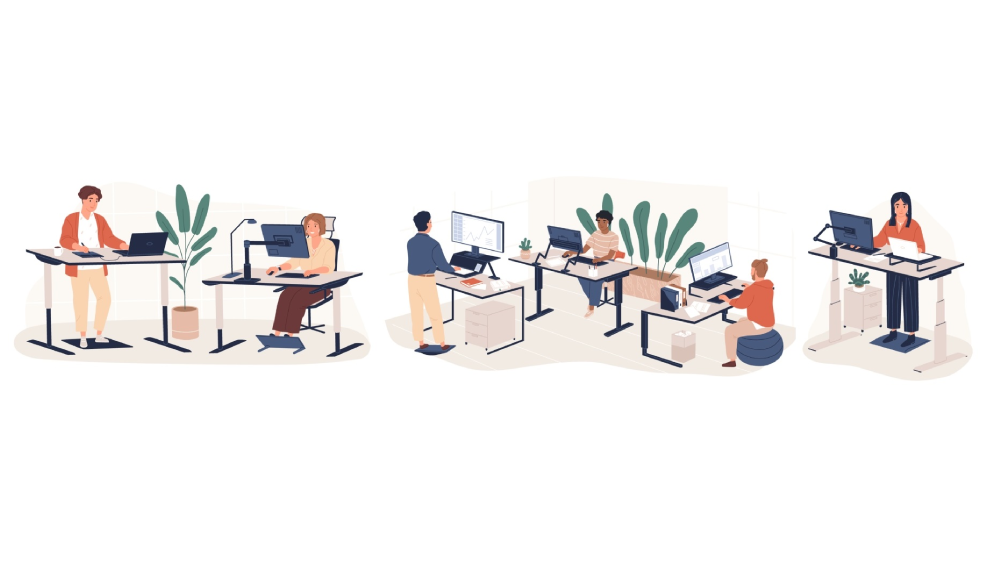All the pros and cons of using a standing desk
- Overview
What is a standing desk?
Standing desks (also known as stand-up or adjustable desks) are a recent workplace innovation that allows the user to raise and lower the desk to a height that suits them. This means you can switch between a standing and a traditional seated position incrementally throughout the day.
A standing desk uses a mechanical or electronic element to raise or lower the workstation platform so you can comfortably stand up while working. Standing desks are available in a range of designs at a price point to suit you. They’re a recent workplace innovation that’s designed to improve spinal and circulatory health.
The health benefits
People who live a sedentary life and work long hours in a seated position are at an increased risk of developing chronic health conditions like diabetes, heart failure and obesity.
- Burn more calories: standing burns more calories than sitting. This means that just by standing and doing the same amount of work, you are already improving your health
- Improved posture: the problem with workplace desks is that they lack a correct ergonomic setup. A standing desk can be raised or lowered, allowing you to tailor the height of your work platform and your screens to suit you
- Encourage circulation: sitting or standing still for long periods encourages blood and fluid to pool in the bottom half of the body. Mixing up your working position helps lower your risk of developing blood clots that can lead to a stroke or a pulmonary embolism
- Reduce the need for constant breaks: if you’re seated all day, you may feel the need to take incremental standing breaks. A standing desk allows you to stretch out whilst you continue with the task at hand
- Improved energy levels: 87% of those who switched to a standing desk during a clinical study reported increased energy throughout the day. Upon returning to their normal desks, results indicate that mood returned to its previous level
- A stronger core: standing up gently tenses the core muscles and engages more of your midsection, building up strength in your core and abdominal area
- Lowered risk of obesity and diabetes: a standing desk helps lower your risk of developing diabetes. The act of standing up also burns more calories than sitting down, making it a calorie burning alternative to a sedentary seated position.
Improve your posture whilst working

Sitting for long periods can become very uncomfortable and is not good for our overall wellbeing. We can start to get pain in our hips, back and shoulders and this can worsen if you already experience pain.
Standing at your workstation enables you to generally move and change posture more regularly. If you already have issues with your back or posture, a standing desk is a great choice because it encourages movement. To ease into standing at work, try one hour of standing for every two hours you spend seated.
Burn calories whilst you work
Prolonged sitting has been associated with an increased risk of obesity. Using a standing desk can help counteract this risk by promoting calorie expenditure throughout the day. When you stand, you engage the muscles in your legs and your core, which also promotes higher energy expenditure when compared to sitting.
- Concerned about your sedentary job? Click here to learn more
Combat neck pain
Better posture and the ability to intermittently switch between a standing a seated position can help lessen neck pain. The ability to move more can loosen the muscles in your neck, leaving you feeling fresher, for longer.
To lessen neck pain and strain, ergonomically arrange your desk and workspace so the top of your monitors are at eye level and all accessories and peripherals you need are close by to avoid stretching and straining. These rules apply when you’re working in your seat and when you’re stood up.
Improve circulation and cardiovascular health
Intermittently standing and sitting down encourages better circulation and blood flow. This can help prevent blood from pooling in the legs, reducing your risk of developing conditions like deep vein thrombosis and blood clots. Improved circulation also supports heart health by enhancing blood flow and reducing the strain on the cardiovascular system.
Strengthen your core muscles
When you stand, your core muscles are engaged to keep you upright and stable. Over time, standing at your desk can work in tandem with a good exercise routine and an active lifestyle outside of work to build stronger core muscles.
- Need some help? Try our ten-minute core workout
Lower your risk of diabetes
A sedentary lifestyle has also been linked to a higher risk of developing type 2 diabetes. Incorporating periods of standing into your work routine helps negate your risk by burning calories passively whilst you work.
This small change can go a long way if you’re making multiple little adjustments to your lifestyle to lower your long term risk of developing diabetes.
Improve concentration and energy levels

Switching positions is a great way to get yourself back into work mode after a long meeting or wrapping up a particularly laborious task.
Standing while working can enhance focus and concentration by increasing blood flow to the brain. This can help improve cognitive function and even lead to better productivity and task performance.
Conversely, sitting for extended periods can lead to feelings of sluggishness and fatigue. Standing promotes better blood circulation and oxygen delivery to tissues, helping you feel more awake and energised throughout the day.
Getting started with your standing desk
When you first get your standing desk, you might be wondering how to use it to maximise the health benefits on offer.
Take a look below for some top tips on how to get the most out of your standing desk when it arrives:
- Start small: if you're new to using a standing desk, begin by alternating between sitting and standing for short periods. Gradually increase your standing time over several days or weeks. A good rule of thumb to start with is to sit for two hours, stand for one
- Prioritise ergonomics: adjust your desk and monitor height to ensure the top of your screen is at eye level, and your arms are at a 90-degree angle
- Wear the right shoes: supportive, cushioned shoes are not to be overlooked. When standing still, they can help alleviate discomfort and provide adequate support for your feet, ankles, and knees
- Take breaks: a standing desk doesn’t remove the need for breaks away from your desk. You still need to take short breaks to walk around and stretch
- Listen to your body: if you experience any discomfort or pain, adjust your standing time or posture accordingly. Consult a healthcare professional if these issues persist.
Frequently asked questions
We put everything we wish we knew before buying a standing desk in one place to save you time. Take a look at some frequently asked questions, below.
Hand crank or electronic?
Hand cranked and electronic riser models are the two most popular styles of standing desks available.
Electronic desks can lift more than manually cranked ones because they aren’t reliant on user input. The downside is that the electronic element inside makes them more susceptible to failure and damage. Electronic desks are also more efficient. Buttons are usually placed close to the centre of the desk so you can efficiently lower or raise your desk as and when required.
The one advantage of a hand cranked desk is that they tend to be cheaper than electronic models. Their affordability and ease of repair in the event of a break make them a viable alternative to an electronic option.
Can I use a standing desk with a laptop and a desktop?
Yes, you can use a standing desk with a desktop or laptop. Consider your current setup before purchasing, as the wires required for a desktop setup may need a specific style of desk to safely accommodate the rise function.
Can a standing desk make me more productive?
Whilst research is still being conducted on the subject, the current consensus is that a standing desk doesn’t appear to negatively impact productivity.
Can I use a walking treadmill with my standing desk?
The idea behind a treadmill desk is that you engage in very light physical activity while working. If you’re taking calls or doing some writing, you can continue to browse your screen whilst walking on the treadmill below.
You can buy “all in one” style treadmill desks or purchase a separate treadmill that sits underneath your desk setup. Before purchasing, consider the type of work you do and whether or not you will be able to work comfortably and productively whilst walking at a slow pace.
Do people still get back pain with a standing desk?
The hours we spend at work only make up around a third of our day. Whilst that sounds like a lot, if your sleeping position or exercise regime cause you back pain outside of the workplace, standing at a desk is not going to eliminate this.
If you are experiencing chronic back pain or you have purchased a standing desk and are still in pain, we recommend booking an appointment with a physiotherapist. A Nuffield Health physio can analyse your posture to get you working in a way that suits you and your body.
Are standing desks safe?

The mechanism inside a standing desk responsible for raising and lowering the platform has a maximum speed built in, meaning the worktop can’t quickly jolt up or down whilst you’re working.
Regardless of price point or quality, standing desks are designed to move up and down smoothly to prevent accidents. If you’re concerned about the height of your desk when it’s in standing mode, consider not placing things like glasses and breakables on your work platform.
Can I still sit at a standing desk?
Absolutely. The idea behind a standing desk is that it can be lowered and raised to accommodate both a seated and standing position. If you like to stand whenever you’re at your desk, we recommend you completely adjust your screen, keyboard and mouse setup to reflect your positioning.
Is standing up at work harmful?
There is no magic formula for eliminating pain and discomfort at work. That’s why the flexibility and ability to intermittently change position that a standing desk offers is optimal.
Depending on your condition, standing for long periods can be just as harmful as sitting for long periods. Somebody with excellent posture who takes regular breaks at a regular seated desk will experience less pain than someone with degenerative disk disease who stands all day without taking a seated break.
Last updated Tuesday 23 January 2024
First published on Monday 20 November 2023

